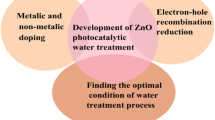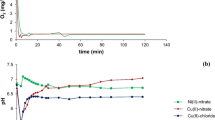Abstract
Purpose of work Hydrodehalogenation of persistent pollutants, such as the groundwater contaminants trichloroethylene and diatrizoate, are catalyzed by biogenic Pd nanoparticles. As H2 gas supply for the dehalogenation reactions is still the limiting factor, this study examines in situ H2 production in the cathode of a microbial electrolysis cell.
In a biogenic Pd nanoparticle (bio-Pd) free microbial electrolysis cell (MEC), dechlorination of trichloroethylene (TCE) with concomitant chloride and ethane formation was achieved in the cathode compartment at a removal rate of 120 g TCE m−3 total cathode compartment (TCC) day−1, applying −0.8 V with a power source. When the cathode granules were coated with 5 mg bio-Pd g−1 graphite, chloride and ethane formation increased to 151 g TCE m−3 TCC day−1 corresponding with a specific removal rate of 48 mg TCE g−1 Pd day−1. In both cases, formation of unwanted byproducts, such as vinyl chloride, was not significant. When the same setup was applied for transformation of the iodinated contrast medium diatrizoate (diaI3), reduction in a catalyst-free cathode of a MEC resulted in a removal of 48 ± 9% during the first h corresponding to 3 g diaI3 m−3 TCC day−1. Coating the cathodic graphite granules with bio-Pd enhanced the transformation resulting in a 93 ± 4% removal during the first h corresponding to 6 g diaI3 m−3 TCC day−1. These results suggest that MECs can produce H2 in a sustainable way to provide an economical interesting reactant for bio-Pd catalyzed dehalogenation reactions.


Similar content being viewed by others
References
Al-Abed SR, Fang YX (2007) Use of granular graphite for electrolytic dechlorination of trichloroethylene. Environ Eng Sci 24(6):842–851
Aulenta F, Canosa A et al (2008) Trichloroethene dechlorination and H-2 evolution are alternative biological pathways of electric charge utilization by a dechlorinating culture in a bioelectrochemical system. Environ Sci Technol 42(16):6185–6190
Baxter-Plant V, Mikheenko IP et al (2003) Sulphate-reducing bacteria, palladium and the reductive dehalogenation of chlorinated aromatic compounds. Biodegradation 14(2):83–90
Clauwaert P, Desloover J et al (2009) Enhanced nitrogen removal in bio-electrochemical systems by pH control. Biotechnol Lett 31(10):1537–1543
De Windt W, Aelterman P et al (2005) Bioreductive deposition of palladium (0) nanoparticles on Shewanella oneidensis with catalytic activity towards reductive dechlorination of polychlorinated biphenyls. Environ Microbiol 7(3):314–325
De Windt W, Boon N et al (2006) Biological control of the size and reactivity of catalytic Pd(0) produced by Shewanella oneidensis. Antonie van Leeuwenhoek 90(4):377–389
Deplanche K, Snape TJ et al (2009) Versatility of a new bioinorganic catalyst: palladized cells of Desulfovibrio desulfuricans and application to dehalogenation of flame retardant materials. Environ Technol 30(7):681–692
Foley JM, Rozendal RA et al (2010) Life cycle assessment of high-rate anaerobic treatment, microbial fuel cells, and microbial electrolysis cells. Environ Sci Technol 44(9):3629–3637
Freguia S, Rabaey K et al (2007) Non-catalyzed cathodic oxygen reduction at graphite granules in microbial fuel cells. Electrochim Acta 53(2):598–603
Harrad S, Robson M et al (2007) Dehalogenation of polychlorinated biphenyls and polybrominated diphenyl ethers using a hybrid bioinorganic catalyst. J Environ Monit 9(4):314–318
Hennebel T, De Gusseme B et al (2009a) Biogenic metals in advanced water treatment. Trends Biotechnol 27(2):90–98
Hennebel T, Simoen H et al (2009b) Biocatalytic dechlorination of trichloroethylene with bio-Pd in a pilot-scale membrane reactor. Biotechnol Bioeng 102(4):995–1002
Hennebel T, Verhagen P et al (2009c) Remediation of trichloroethylene by bio-precipitated and encapsulated palladium nanoparticles in a fixed bed reactor. Chemosphere 76(9):1221–1225
Hennebel T, De Corte S et al (2010a) Removal of diatrizoate with catalytically active membranes incorporating microbially produced palladium nanoparticles. Water Res 44(5):1498–1506
Hennebel T, Simoen H, et al (2010b) Biocatalytic dechlorination of hexachlorocyclohexane by immobilized bio-Pd in a pilot scale fluidized bed reactor. Environ Chem Lett. doi:10.1007/s10311-010-0295-x
Knitt LE, Shapley JR et al (2008) Rapid metal-catalyzed hydrodehalogenation of iodinated X-ray contrast media. Environ Sci Technol 42(2):577–583
Mertens B, Blothe C et al (2007) Biocatalytic dechlorination of lindane by nano-scale particles of Pd(0) deposited on Shewanella oneidensis. Chemosphere 66(1):99–105
Mu Y, Rabaey K et al (2009a) Decolorization of azo dyes in bioelectrochemical systems. Environ Sci Technol 43(13):5137–5143
Mu Y, Rozendal RA et al (2009b) Nitrobenzene removal in bioelectrochemical systems. Environ Sci Technol 43(22):8690–8695
Rasten E, Hagen G et al (2003) Electrocatalysis in water electrolysis with solid polymer electrolyte. Electrochim Acta 48(25–26):3945–3952
Rozendal RA, Hamelers HVM et al (2006) Principle and perspectives of hydrogen production through biocatalyzed electrolysis. Int J Hydrogen Energy 31(12):1632–1640
Turner JA (2004) Sustainable hydrogen production. Science 305(5686):972–974
Acknowledgments
This work was part of a research project obtained from the EU Commission within the Energy, Global Change and Ecosystems Program of the Sixth Framework (FP6-2005-Global-4): EU Neptune project (036845, SUSTDEV-2005-3.II.3.2). Tom Hennebel was supported by the Fund of Scientific Research-Flanders (FWO, 7741-02) and the German Academic Exchange Service (DAAD) is acknowledged for the postdoctoral fellowship of Jessica Benner.
Author information
Authors and Affiliations
Corresponding author
Additional information
Tom Hennebel, Jessica Benner contributed equally to this article.
Electronic supplementary material
Below is the link to the electronic supplementary material.
Rights and permissions
About this article
Cite this article
Hennebel, T., Benner, J., Clauwaert, P. et al. Dehalogenation of environmental pollutants in microbial electrolysis cells with biogenic palladium nanoparticles. Biotechnol Lett 33, 89–95 (2011). https://doi.org/10.1007/s10529-010-0393-7
Received:
Accepted:
Published:
Issue Date:
DOI: https://doi.org/10.1007/s10529-010-0393-7




